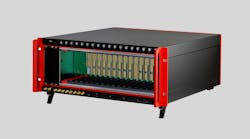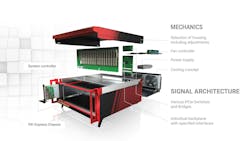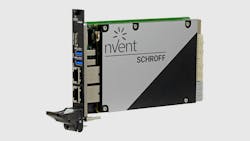Go Beyond the Standard with Customizable PXle Systems
What you’ll learn:
- Benefits of customizing PXIe systems.
- How system architecture customization can be a powerful tool for creating PXI and PXIe systems tailored to specific application requirements.
- How to leverage modular components and customization options to design systems that are both cost-effective and highly effective for intended applications.
PCI eXtensions for Instrumentation (PXI) and PXI Express (PXIe) are open-standard test platforms that have been widely adopted by various industries, including aerospace, automotive, consumer electronics, process control, and industrial automation. These standards have evolved over the last two decades, benefiting from continuous innovation.
With access to modular components, test and measurement companies can leverage these standards in their proprietary solutions and avoid overextending on cost or time when it comes to developing test systems.
The hallmark of PXI and PXIe is their modularity. A PXI system consists of three key components: system controller, PXI chassis, and cPCI/PXI peripheral cards. The system controller is a physical card slotted in the side of the rack or a remote-controlled function. The chassis, a mechanical housing with up to 18 slots, features a backplane, power sources, cooling mechanisms, and space for the controller. Peripheral cards slot into the chassis and serve a variety of test and measurement functions.
By mixing and matching these modular components, companies can design custom test and measurement systems that are highly effective for their intended applications without excessive cost.
Evolution of PXI and PXIe in Test and Measurement
The PXI standard, developed in 1997, is based on the peripheral component interconnect (PCI) and compact PCI (cPCI), although it’s specifically designed for the purposes of test and measurement.
PXI leveraged the high sample rates, low-latency triggers, and high-accuracy clock architecture from PCI and cPCI to meet the unique needs of test and measurement. On the other hand, PXIe implemented the Peripheral Component Interconnect Express (PCIe) bus on PXI platforms. That allowed for backwards compatibility with PXI while incorporating new capabilities as PCIe evolved.
Like PCIe, there are several different generations of PXIe, and each one fits different applications and price points. The first two generations are best suited for amplifiers and arbitrary function generators. The third generation and beyond are most useful for real-time receivers and spectrum analyzers, high-speed digitizers, and arbitrary waveform generators. Bandwidth jumps from 1 GB/s up to 24 GB/s in the third generation to support today’s most demanding test applications.
PXI and PXIe are best known for their high accuracy and precision, flexible triggering options, and high-speed data acquisition, which improve measurement speed and productivity for all types of automated test applications. But while these standards are designed to support as many applications as possible with off-the-shelf components, their flexibility is only useful if you know what to do with it.
For companies with specific design requirements, figuring out the best combination of PXI and PXIe components can be a daunting task.
Taking PXI and PXIe Customization to the Next Level
Since PXI and PXIe are open standards, users can select components such as the chassis, the system controller, and measurement cards, and then link everything together with software from different vendors to build a full application.
However, it’s also possible to work with solutions providers to assemble the chassis itself out of “functional modules,” which are a subset of the main building blocks in a PXI or PXIe test system. For instance, nVent SCHROFF has a huge program of mechanical components, including fans and fan trays, which can be used to build either a rack-mount chassis or a desktop chassis in various form factors.
Some providers also offer system architecture customization for PXI and PXIe. That involves the use of special interface modules such as PCIe switches and PCIe-to-PCI bridges. These can be integrated into the backplane to bring a custom signal topology into play. Other modules in this class include clock modules and chassis-management modules, which solutions providers can typically mix and match in standard or customized chassis.
Besides electronic modules, specialized interface modules can be used in other applications, such as power management and communication. These modules are able to add new capabilities to a system or replace existing modules with more advanced versions over time. Moreover, users can also bring aboard a wide variety of power supplies to their custom PXI and PXIe systems.
With these mechanical and electronic modules, customization becomes much easier. Time-to-market is also reduced because there’s a well-designed foundation for these types of systems.
Benefits of Custom PXI and PXIe Test Systems
Using functional modules on the backplane design is beneficial for multiple reasons:
- Easy integration: Universal form factors simplify system configuration, resulting in reduced setup time and improved test efficiency.
- Scalability: To accommodate changing testing needs, functional modules make it easier to add or remove instruments and scale capabilities. Changing out functional modules also incurs lower risk than full redesigns.
- Resilient and remote topology: In the absence of cascading, a defect in a single functional module doesn’t impact other modules or the overall system. Furthermore, for systems that accommodate a variety of testing functions, features can be left unassembled when not in use to allow the system to focus on other specific functions and save costs.
- Risk reduction: Simpler, blocked/black-boxed concepts enable engineers to leverage proven technologies while protecting their intellectual property.
- Flexibility: Standard chassis designs typically range from 3U to 9U and have between 8 and 18 slots. Modular power supplies support different input voltages. With a wide range of cooling solutions, from convection to forced-air cooling, users can design systems that suit their specific thermal requirements. Chassis customization options range from mechanical adjustment to corporate designs, including paint, logo printing, and color matching.
- Reliability: Functional modules are rigorously tested and verified.
Selecting the Right Partner for PXI and PXIe Systems
In the end, solutions providers are creating these functional modules for themselves—to reuse as many components as possible, not reinvent the wheel for every customization, and save costs.
But ultimately, their customers reap the rewards. They get a solution tailored to their requirements in a much shorter time without expending as much effort on engineering. There’s reduced risk of design errors and failure during evaluation and certification. The cost savings can be passed on, too.
When looking for a customization partner, it pays dividends to have a direct line to the supplier’s engineering department for timely support—both for the duration of a specific project and beyond.
Also, additional services can be helpful to consider such as circuit design and analysis; electromagnetic-compatibility (EMC) testing; simulations for thermal analysis, prototyping, and air performance measurements; and simulations for voltage drop, signal integrity, and loss effects.
Overall, system architecture customization can provide companies with a powerful tool to create PXI and PXIe systems that are tailored to the needs of their specific application.


